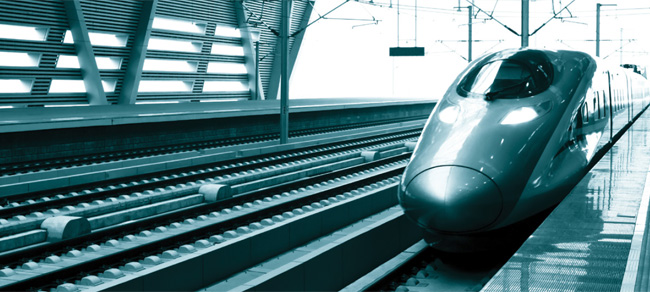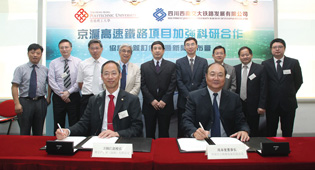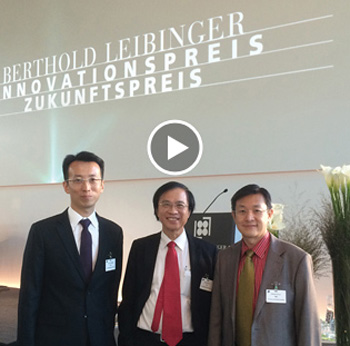
Building better rail networks

Prof. Alex Wai, PolyU Vice-President (Research Development) (left on front row) and Prof. Zhou Benkuan, Chairman of Board of Directors of The Southwest Jiaotong University Railway Development Co. Ltd. (right on front row) jointly sign an agreement on the collaboration in research and technology development.
In announcing the prize, the Berthold Leibinger Stiftung commented that “the beauty of the technology is manifold.” Indeed, the organization was not alone in noticing the advantages of using FBG technology in railway operations. In addition to Hong Kong’s railway network, rail operators around the world are beginning to adopt the new technology in their running systems.
One of the first to do so was the Beijing-Shanghai High-Speed Rail Line, which incorporated PolyU’s Advanced Fibre Bragg Grating Railway Monitoring System into major sections during 2011. The aim was to gather real-time data on vibrations, acceleration and temperature changes for use in monitoring the condition of tracks and railcars and the structural health of the rail foundation.
Cooperation with Dalian Jiaotong University also saw the installation of PolyU-developed FBG sensors in high-speed inspection trains for rail monitoring. More recently, Transport Sydney in Australia plans to install the sensors in its first driverless trains, where they will be used to provide the feedback that is critically important to the safety of the system.
Another user, Southwest Jiaotong University (SWJTU), through its Railway Development Company, recently expanded its cooperation with PolyU’s Base for Commercialization, Training and Research in Shenzhen. Having already collaborated on installing FBG sensors in the mainland’s high-speed trains, the two parties signed an agreement in Hong Kong during June 2014 to further advance the development of the high-speed rail network and technology.
Speaking at the signing ceremony, Prof. Alex Wai, PolyU Vice-President (Research Development) said that the "agreement means closer collaboration in developing new railway technologies." Prof. Zhang Weihua, Director of the State Key Laboratory of Traction Power of SWJTU agreed, saying that "there will be closer collaboration with PolyU in further exploring applied technologies in railway."
PolyU and SWJTU have already collaborated on developing techniques in controlling vibration in high-speed rail cars. Not only are these vibrations uncomfortable for passengers, they can seriously increase wear and tear on the carriages and tracks. Any construction defect can have major consequences for a train travelling at over 300 kilometres per hour.
Prof. Ni Yiqing, from PolyU’s Department of Civil and Environmental Engineering, said "this research succeeded in reducing adverse vibration by using damper when travelling at a speed of over 300 kilometres per hour". This provides stability and comfort in ride, and prolongs the life of the train in operation.
The continued partnership with SWJTU puts PolyU on track to make further crucial contributions to China’s high-speed rail projects. With this critical building block in place, and research continuing to provide innovative solutions to the challenges of inspection and monitoring, the future looks bright for rail travel. ♦

